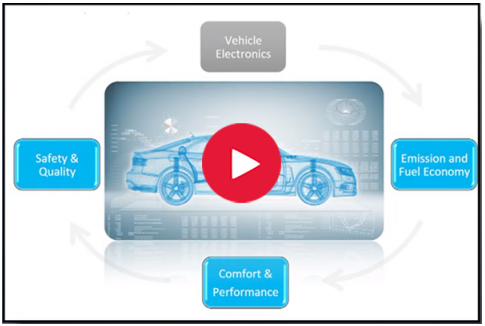Tata Motors Standardizes on PSpice Technology for Automotive Design Simulations
Tata Motors, India’s largest automobile company, is part of the US$100-billion Tata Group founded by Jamsetji Tata in 1868. Tata Motors Limited, a US$42-billion organization, is a leading global automobile manufacturer with a portfolio that covers a wide range of cars, sports vehicles, buses, trucks, and defense vehicles. In 2008, the company acquired Jaguar and Land Rover. Established in 1945, Tata Motors is now a 60,000-employee company with design and R& D groups located in India, UK, Italy, and Korea. The Tata Motors Pune R& D Centre handles most electrical and electronics-related work.
Key Challenges
Today, more and more electronics—from passenger safety systems to other safety and convenience features—are being added to cars. Indeed, vehicles now typically boast more than 100 ECUs distributed under the hood and in the interior from different vendors. This is creating a range of design and validation challenges in communication, coordination, power distribution, and other areas of automotive design simulations.
“With all of the new electronics, there’s always a risk that something will fail. That’s why it’s critical to simulate all of these electronic circuits to verify their functionality and reliability based on component tolerances, temperature variations, and other parameters. It is even more crucial for automotive companies to perform exhaustive simulations and yield and reliability analysis to ensure that there are no field failures that would require recalls,” said Santosh Birajdar, senior manager, Electrical and Electronics PV at Tata Motors in Pune, India.
Tata Motors needed to evaluate electronic interfaces for compatibility and robustness against a variety of automotive conditions, including:
- Noise factors like ground shift, shared grounds, and coupled transients
-
Switches and relays
-
Contact cleaning current
-
De-bounce
-
Voltage transients like device damage, latch-up, and dropout
The Solution
To avoid and/or resolve error states prior to hardware freeze, Tata Motors used Cadence's OrCAD® PSpice® Designer to perform electronic control unit (ECU) (stand-alone with associated sensors and loads) and ECU-to-ECU simulations. Using the tool, the automotive manufacturer performed steady-state analysis, transient analysis, and system/subsystem analyses. The company also performed transient simulations for transient immunity verification (ISO Pulse 1-5) and simulated several automotive abuse conditions to Identify failures such as:
- Short to battery
- Short to ground
- Jump start
- Ground shift conditions
- Reverse battery condition
During steady-state analysis, Tata Motors verified actual circuit behaviors for worst-case analysis with regard to the Tier 1 ECU Supplier Electrical Specification Table. The engineers identified failures and risks using analysis methods like DC sweep, parametric sweep, Monte Carlo, and temperature sweep of PSpice analysis methods. With test cases defined based on vehicle platform requirements, some of the spcification verified include:
- Worst-case input voltage required from source to detect as logic high / logic low at normal and ground shift condition (to ECU)
- Worst-case minimum and maximum current drawn from source at normal and ground shift condition (by ECU)
- Worst-case output voltage to another ECU or LOAD at normal and ground shift condition (from ECU to ECU or ECU to load)
-
Worst-case minimum and maximum source current/sink current to ECU to ECU or ECU to load at normal and ground shift condition (from ECU to ECU or ECU to load)
Regarding transient analysis, Tata Motors created transient pulse models per OEM ISO Pulse requirements using sub-circuit concepts. The engineers applied transient pulse to the circuits under simulation to verify the circuit performance and internal protection circuitry based on their agreement with a Tier 1 supplier. They also created transient pulse models based on worst-case vehicle-level transient signature observations.
In system/ subsystem analysis, ECU hardware Interfaces with different loads, such as actuators and motors, and inputs like sensors can be verified together and issues can be highlighted prior to design freeze to help provide a complete risk assessment, Birajdar explained. He noted that motor/sensor loads are simulated using MathWorks MATLAB. The company uses PSpice technology to design their circuits based on these specifications, providing simulation with more realistic models that exhibit nonlinearities, delay, and other real-life effects. Through co-simulation, the engineers can test system level interfaces with actual electrical designs without the need to prototype the complete system. "With OrCAD PSpice Designer, design problems are found much earlier, saving crucial time and money often spent in building and debugging ECU boards within system prototypes," said Birajdar.
To take advantage of PSpice technology together with MathWorks Simulink Simulators, Tata Motors used PSpice SLPS Option to verify system performance. The engineers developed electronic circuits using PSpice technology and electromechanical models using Simulink simulators. "With SLPS co-simulation concepts, both are interfaced together to verify system-level behavior," said Birajdar.
The Results
By using OrCAD PSpice Designer, Tata Motors quickly identified stress on components at different conditions, evaluated power dissipation, and even Simulated their ECU subsystem with other automotive electronic subsystems (such as powertrain sensors, radiator fans, and door actuators), reducing its ECU component lifecycle by six months . The company detected supplier design problems and possible errors in vehicle interfaces much earlier in the cycle, saving the time and money that building and debugging ECU boards within system prototypes would have required. Overall, noted Birajdar, PSpice A/D and Advanced Analysis provide an excellent simulation and debug environment for automotive designs
"With OrCAD PSpice Designer, we have a single tool for performing ECU and ECU-to-ECU simulations and for system Interface modeling," said Birajdar. "We can verify performance issues, complete risk assessment, and identify integration problems before hardware freeze. PSpice Advanced Analysis helped us reduce costs, improve product reliability and engineering productivity, and, ultimately, deliver ECUs that meet the rigorous quality and reliability standards of the automotive industry.
Summary
Tata Motors plans to continue using OrCAD PSpice Designer and PSpice Advanced Analysis for verifying the ECU subsystem with other automotive electronic subsystems. "The accuracy of PSpice models and the ease of creating new models saves us time and provides us the confidence in releasing our products to market," said Birajdar.


